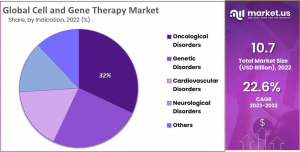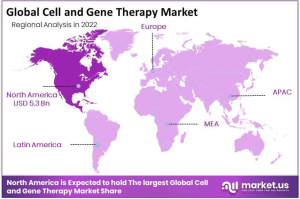
Cell and Gene Therapy Market: A Revolution in Pharma by 2033
The Specialty Pharmaceutical Market size is expected to be worth around USD 1532.8 billion by 2033, from USD 68.3 billion in 2023.
NEW YORK, NY, UNITED STATES, January 23, 2025 /EINPresswire.com/ -- The Global Cell and Gene Therapy Market is projected to experience significant growth, with an estimated value of USD 78 billion by 2032, up from USD 10.7 billion in 2022. This remarkable expansion, at a compound annual growth rate (CAGR) of 22.6% from 2023 to 2032, signals a transformative era in pharmaceutical and therapeutic methods. The market's growth is driven by the convergence of advanced scientific techniques that modify or replace defective genes, offering potential cures for various genetic disorders and diseases.
Several factors are propelling this market forward. Technological advancements in gene editing tools like CRISPR and TALENs have significantly improved the safety and efficacy of therapies. Additionally, the increasing prevalence of genetic disorders globally necessitates effective treatment solutions. Enhanced regulatory support and substantial funding from both public and private sectors are also crucial, accelerating research and approvals. Furthermore, strategic partnerships among biotech firms and pharmaceutical giants are crucial for expanding capabilities and hastening market entry.
However, the market faces several challenges. The high costs associated with complex manufacturing processes and the bespoke nature of treatments hinder accessibility. Ethical debates and stringent regulatory requirements further complicate widespread adoption. Moreover, developing safe and effective delivery systems remains a significant technical hurdle that the industry must overcome.
Looking ahead, the future of the Cell and Gene Therapy Market is marked by continued innovation and expanding applications. As technology advances and regulatory environments evolve, these therapies are expected to become more accessible, offering new hope for patients with previously untreatable conditions. By 2033, this market is anticipated to revolutionize treatment paradigms across the pharmaceutical landscape, promising substantial health improvements and economic benefits.
Get Sample PDF Report: https://market.us/report/cell-and-gene-therapy-market/request-sample/
Key Takeaway
• The market is set to grow at a CAGR of 22.6%, expected to reach USD 78.0 billion by 2032, up from USD 10.7 billion in 2022.
• Cell therapy dominates the market with a 54.3% share, with both cell and gene therapies revolutionizing medicine.
• Growth is fueled by increased investments from public and private sectors, an expanding clinical pipeline, and healthcare infrastructure improvements.
• Major challenges include high production costs, stringent regulations, and prolonged clinical study processes that limit growth.
• Oncological disorders were the leading segment in 2022, holding a 32% market share.
• Genetic disorders are projected to grow rapidly due to increasing cases and targeted government initiatives.
• Hospitals are expected to see the highest growth rate among end-users during the forecast period.
• A notable trend is the increase in global R&D spending and the development of innovative therapies.
• North America led in market revenue in 2022, with a 49.6% share, driven by robust research and regulatory support.
• Asia-Pacific is poised to capture the largest revenue share in the coming years, presenting significant market opportunities.
Segmentation Analysis
The global cell and gene therapy market is broadly categorized into cell and gene therapies. In 2022, cell therapy emerged as the dominant segment, capturing 54.3% of the market revenue. This growth is fueled by its applications in treating autoimmune diseases, cancers, and urinary issues. Enhanced funding for novel cell lines and strategic growth initiatives by companies further stimulate this segment’s expansion. Cell therapy involves introducing healthy cells into the body to replace diseased or damaged ones, thereby restoring or altering cellular function.
Gene therapy, which focuses on altering the genetic structure of cells to treat or reverse diseases by repairing damaged genes, held a significant market share during the historical period. It is now projected to maintain the second-largest share. Meanwhile, the oncological disorders segment led the market in 2022, holding a 32% share. This segment benefits from advances in cell and gene therapies that target the root causes of hereditary diseases, improving treatment outcomes.
The market analysis by end-user shows hospitals as the leading segment, anticipated to grow rapidly due to their pivotal role in administering new therapies. Cancer care centers also show notable growth, with a projected CAGR of 5.3%. These institutions are crucial for providing specialized treatments and are integral to the broader adoption of innovative therapies in the cell and gene therapy market.
By Therapy Type
• Cell Therapy
• Gene Therapy
By Indication
• Genetic Disorders
• Cardiovascular Disorders
• Neurological Disorders
• Oncological Disorders
• Other Indications
By End-User
• Hospitals
• Academic & Research Institutes
• Cancer Care Centers
• Other End-Users
The Primary Entities Identified In This Report Are:
• GalaxoSmithKline plc
• Novartis AG
• Amgen Inc.
• Bristol-Myers Squibb Company
• Spark Therapeutics
• Pfizer Inc.
• Biogen Inc.
• Thermo Fisher Scientific Inc.
• Other Key Players
Regional Analysis
North America leads the global cell and gene therapy market, holding a substantial revenue share of 49.6%. This dominance is primarily due to the rising incidence of cancer and an increase in research activities focused on cancer and stem cells. The region benefits from enhanced infrastructure, a significant number of active clinical trials, and active engagement from companies in gene and cell therapy development. The regulatory environment in the U.S. further supports market growth, characterized by the FDA's collaborative approach to cell and gene therapy approvals.
Europe secures the second-largest revenue share in the cell and gene therapy market. The region's growth is fueled by several innovative research collaborations and experiments, particularly in gene therapy using viral vectors. These initiatives are likely to propel the market forward in Europe. The established infrastructure and skilled workforce in Europe also contribute significantly to the market's expansion, ensuring sustained development in this sector.
The Asia-Pacific region is projected to capture the highest revenue share in the coming years, driven by its developing infrastructure and increasing investments in healthcare research. This region's market growth is anticipated to accelerate due to a combination of advanced technological integration and rising healthcare demands, positioning it as a critical area for future market expansion in cell and gene therapy.
Buy Directly: https://market.us/purchase-report/?report_id=101909
Emerging Trends in Cell and Gene Therapy
• Focus on Non-Oncology Indications: The field of cell and gene therapy (CGT) is broadening beyond cancer treatments to target a variety of other diseases, with companies developing therapies for conditions like liver diseases and autoimmune disorders. This expansion indicates a significant shift towards treating a wider range of chronic and genetic diseases with CGT.
• Advancements in In Vivo Gene Editing: There is a growing focus on enhancing in vivo gene editing techniques, which allows for direct modifications within the body, offering potentials for curing diseases by targeting their genetic origins. Techniques such as CRISPR are being advanced to increase precision and reduce off-target effects, crucial for ensuring safety and effectiveness.
• Decentralized Manufacturing: As personalized medicine continues to grow, there is a move towards decentralized manufacturing of therapies. This approach facilitates quicker delivery of treatments to patients and reduces logistical challenges associated with transporting sensitive biological materials.
• Integration of Artificial Intelligence: AI and machine learning are being increasingly integrated into the CGT field, improving the efficiency and precision of gene editing and therapy manufacturing. AI aids in optimizing manufacturing processes and enhancing the quality control of therapies.
• Purpose-built Technologies: There is a rising need for technologies specifically designed for CGT, including small batch production systems for personalized therapies and advanced analytics for real-time process control. These technologies are crucial for scaling up production without compromising the personalized nature of treatments.
Use Cases of Cell and Gene Therapy
• Treatment of Rare Diseases: Gene therapies are particularly effective in treating rare genetic disorders by introducing, removing, or altering genetic material at particular locations in the genome. For instance, therapies targeting rare liver diseases and specific types of cancer have shown promising clinical trial results.
• Personalized Medicine Applications: CGT is at the forefront of personalized medicine, offering treatments tailored to the individual genetic makeup of patients. This includes therapies designed based on the patient’s own cells and genetic profiles, enhancing treatment efficacy and reducing side effects.
• Applications in Immunotherapy: Cell therapies, especially CAR-T cell therapies, have revolutionized the treatment of certain types of cancers by modifying patients' own immune cells to fight cancer more effectively.
• Regenerative Medicine: Gene therapies are also used in regenerative medicine to modify cells that can replace damaged tissues, offering potentials in treating degenerative diseases and injuries.
• Preventative Therapies: For diseases that are known to develop from specific genetic mutations, gene editing provides a method to correct these mutations before the onset of disease, offering a preventative approach to healthcare.
*We offer customized market research reports tailored to meet your specific business needs and requirements.
Lawrence John
Prudour
+91 91308 55334
Lawrence@prudour.com
Distribution channels: Healthcare & Pharmaceuticals Industry
Legal Disclaimer:
EIN Presswire provides this news content "as is" without warranty of any kind. We do not accept any responsibility or liability for the accuracy, content, images, videos, licenses, completeness, legality, or reliability of the information contained in this article. If you have any complaints or copyright issues related to this article, kindly contact the author above.
Submit your press release


